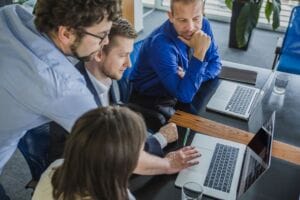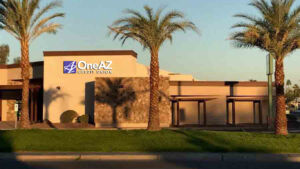On Thursday night, leaders from the Arizona Faith Network, Chispa Arizona, the Arizona Interfaith Power & Light ministry, and more joined a discussion on “The Right to Breathe: Surviving dirty air in Phoenix,” a community-focused bilingual event held in Southern Phoenix at Crosier Village, a Catholic Church.
The three goals of the night, in the words of Amy Bird from the Interfaith Comité of Chispa Arizona, were to have the attendees “hear important stories and see powerful images – things that need to be seen and heard,” “connect more closely with [their] own stor[ies],” and “learn the actions that everybody’s taking,” so “we can figure out the next steps together.”
Dr. Darshan Karwat, an assistant professor in the School for the Future of Innovation in Society and The Polytechnic School at Arizona State University, first shared his story. From Mumbai, a beautiful yet polluted city, where he grew up, he learned firsthand the effects of climate change, particularly air pollution. He quickly became sensitized to the pollution because “it got under his skin,” motivating him towards his work on both environmental issues and social justice.
Dr. Karwat shared geospatial maps of age ranges, poverty levels, minority proportions, and amount of air pollution in Phoenix. The trends within all four maps showed that the western and southern parts of Phoenix are hit the hardest – they are the regions where the majority of the population is under the age of 18, the regions with the highest poverty levels (defined in terms of income), the regions with a higher proportion of minorities, and regions that have the highest pollution score.
Because “air pollution exposure is linked to race and income in Phoenix,” Dr. Karwat said, “the change has to be about the systems.”
“The people who we should be responsible for, we are actually letting down.”
Three different community members, all of whom live in the western or southern parts of Phoenix, shared their personal stories with dirty air.
Ashley Valenzuela, a 13-year-old at Ignacio Conchos School, with the help of her friend and mentor Blanca Arbaca, shared her tales of difficult breathing. The two connected after an incident occurred where Valenzuela was unable to breathe normally, and they both now see each other frequently as they are both dancers with the Ballet Folklorico Itzamatul Del Valle Del Sol dance group that Arbaca organized 6 years ago.
Valenzuela “has every right to breathe clean air, and that’s why we’re here,” Arbaca said.
Ernesto Ramirez, a St. Augustine Church Deacon, grew up away from contamination in a small village in Mexico, he said. “The first 20 years of my life, my lungs breathed pure air.”
After a move to Los Angeles for better opportunities, the first month took a toll on his lungs. They reacted to the contaminated air around him. The doctors were unable to diagnose him, but gave him advice to “try another place to live.”
That’s when Ramirez came to Phoenix. He started to feel better, but that was 30 years ago, he said. “Today is no more cattlefields, today we have apartment buildings, Walmarts, shopping centers.”
Ramirez’ wife then became sick with asthma of her own. She said “is there any place with no contamination? If so, take me there.”
As mother of three and leader on the Ecomadres Team of Moms Clean Air Force, Columba Sainz keeps her children’s health and safety as her number one priority. Just like Ramirez and Valenzuela, Sainz struggles with breathing problems of her own in Phoenix.
With no place in Phoenix to raise her children with clean air, Sainz turned to her community. In the eyes of Sainz, “the true power lies within us.” The Ecomadres Team of Moms Clean Air Force is a collaborative effort between GreenLatinos and Moms Clean Air Force that provides “an inclusive community that empowers and lifts up the the voices of comadres for the benefit of our communities.” Sainz is the Arizona State Coordinator for the program.
Sainz cares about not only the youth, but the entire community, because “we all deserve to breathe clean air,” she said.
Today, Maricopa County has an “F” rating, which is based on the number of high ozone days, from the American Lung Association, according to the health organizations 20th annual “State of the Air” report released in April of this year.
Phoenix as a city, is now the seventh most ozone-polluted city in the nation, behind only six California cities.



